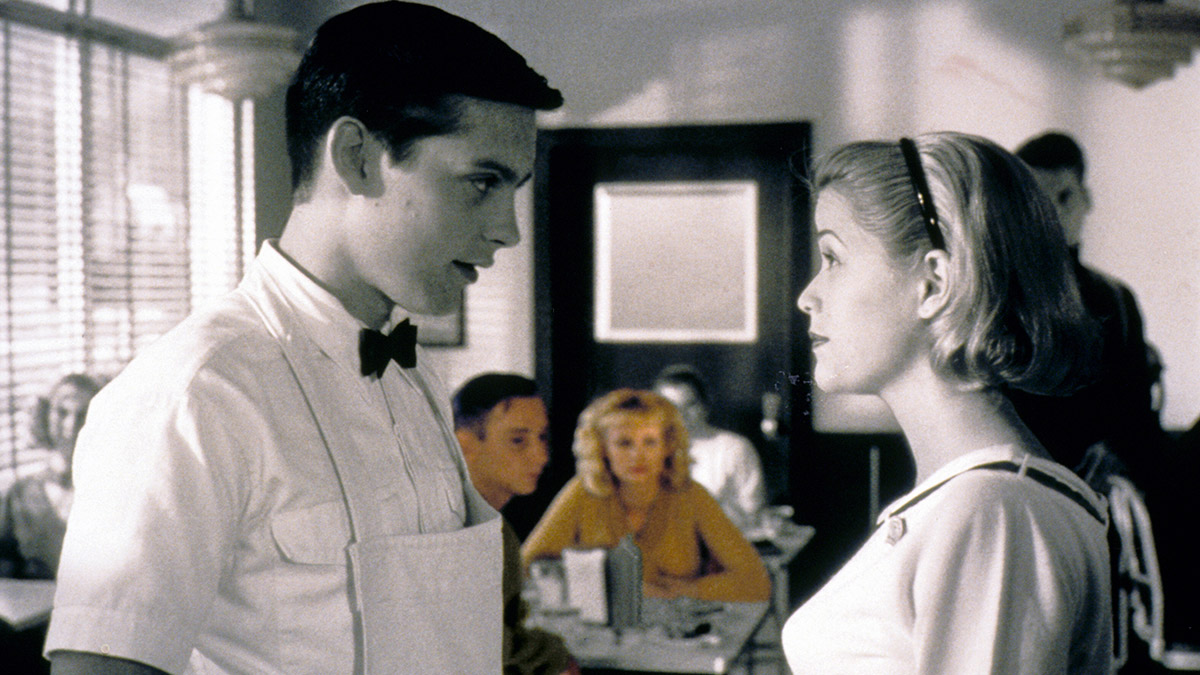
(c) Photofest / Getty Images
“Pleasantville” The division of America suggested by color techniques (Part 1)
2022.09.21
Synopsis ③
Meanwhile, during the day, housewives who were just waiting for their families to come home were busy playing cards and playing bridge. Their topic was that colors were appearing all over the town (all of Betty's cards at this time were red hearts).
Betty asks Mary Sue that question, but it's the first time she's heard the word sex. Mary Sue explains carefully, but her husband George (William H. Macy) doesn't seem interested. There, Mary Sue teaches him how to masturbate. Betty tries it out in the bathroom, and at that moment, the trees in the garden burst into flames (in color).
Bud panics and rushes to the fire station, but the firefighters don't even know about the fire and don't even try to move. So he lied and said, ``The cat couldn't get down from the tree,'' so he sent a fire engine and put out the fire himself with a hose. For this activity, Bud is awarded an honorary award by the town mayor (J.T. Walsh) and instantly becomes a hero of Pleasantville. He then receives a handmade cookie as a gift from his classmate Margaret (Marley Shelton). In the original drama, it was supposed to be given to a boy named Whitey (David Thom).
Coexistence of monochrome and color
Even after color film was developed, many films attempted to use artificial coloring. In Japan, it's called "partial color," and in America, it's called "films partially in color ." However, there are works in which only a portion of the screen is in color, such as ``The Pleasantville'' and ``The Girl in the Red Coat'' from `` Schindler's List '' (1993), and director Yuzo Kawashima's `` The Wild Goose' '. This includes both works in which color and monochrome are mixed for each shot, such as "The Temple of the Earth" (1962) and Tarkovsky's " Planet Solaris " (1972). That's why I'd like to introduce a work called ``Only a Part of the Screen is Color''.
For example, in Roger Vadim's ``Blood and Roses'' (60) (*3), during the dream sequence that Georgia (Elsa Martinelli) has, the screen becomes black and white, and the blood flowing on Carmilla (Annette Vadim)'s dress becomes black and white. and surgeon's gloves are colored red using an optical printer. There are also scenes where only the scenery outside the gate is in color.
Blood and Roses [Et mourir de plaisir] (1960) by Roger Vadim, Clip: Carmilla's dream sequence...
In Japanese films, extremely experimental coloring is attempted in Shochiku's `` Fuefuki River '' (60). Although the work depicts a poor farming family living in the Warring States period, it uses poisonous primary colors that resemble pop art, and the `` Suriya haze '' of a picture scroll is superimposed on a heavy monochrome screen. They completely ignore the subject's context and camera movement, and paint people's faces in blue, pink, or green colors that don't match the content at all. Since Keisuke Kinoshita was also the producer, scriptwriter, and director of the film, there were many people criticizing him at the time of its release. However, the director himself was apparently against this coloring, and the truth seems to be that Shochiku did it on his own.
Among Akira Kurosawa's films, the famous pink smoke in `` Heaven and Inferno '' (63) is famous, but in his previous film `` Tsubaki Sanjuro '' (62), there was also a plan to color only the camellia flowers red. It seems that the Toho Special Technology Division had considered it, but technical issues and inconsistencies in the production came up, and the plan was canceled.
`` Heaven and Inferno '' is said to have inspired Francis Ford Coppola's `` Rumble Fish '' (1983). In this work, only the tropical fish Rumble Fish(betta fish) swim in color on a monochrome screen. This is not an optical composite, but rather a black-and-white photograph of the people looking at the fish (Matt Dillon and Mickey Rourke), which is then rear-projected. They then placed a real aquarium in front of a screen and photographed it using color film.
Rumble Fish color
However, it may be the 1981 Sony Walkman commercial for the United States that directly inspired Gary Ross. People who live in a monochrome world change to color as soon as they listen to music on their Walkman. The world is divided into two groups: people of color who listen to Walkmans and black and white people who do not. From the concept point of view, this has something in common with ``The Pleasantville.''
Sony Walkman Commercial (1981)
(*3) Director Nobuhiko Obayashi was greatly influenced by Blood and Roses, and has used partial color effects in several of his films.
[References]
Written by Sadao Iizuka/Hajime Matsumoto: “The man who continued to draw rays of light” Yosensha (2016)
Continued in the second part
Text: Takayuki Oguchi
In 1982, he became the director of Japan's first CG production, JCGL. After working as the head designer for the IMAX Dome 3D video "Universe 2 ~Sound of the Sun~" at the Fujitsu Pavilion at EXPO'90, he became a freelance video creator. Won an Emmy Award for the NHK special ``Life: A 4 Billion Year Distant Journey'' (1994). He is also a video journalist specializing in VFX, CG, 3D movies, art animation, exhibition videos, etc., and has contributed numerous articles to film magazines, theater pamphlets, the web, etc. In addition to being a visiting professor at Digital Hollywood University, he is also a part-time lecturer at Waseda University's Faculty of Science and Technology, Joshibi University of Art and Design, Tokyo University of the Arts Graduate School of Animation, and Japan Electronics College.
(c) Photofest / Getty Images

